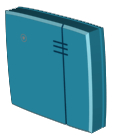Dec. 27, 2002 – Cross Point of the Netherlands is making the transition from product supplier to solutions provider. The company, which makes electronic article surveillance tags and asset tracking equipment, has introduced a complete security system called RFAPP (for Radio Frequency Asset and People Protection).
The system consists of active (battery-powered) RFID tags, activators that wake up the tags, receivers that receive the identification codes and the software needed to manage the system.
Here’s how it works. An active tag is placed on, say, a laptop (it can be used on high-value products, such as DVD players). The ID number is recorded in a database as well as a list of people who are allowed to leave the building with that laptop.
As a person approaches an exit with the laptop, an activator near the door wakes up the active tag, which begins transmitting a signal with its unique ID number and an ID number unique to the activator, so the system can record which exit the person left from. (The system is designed so activators don’t have to be networked.). Receivers can read the tags from up to 20 meters away.
When the person swipes a proximity card to leave, the system checks whether that person is allowed to leave with that particular laptop. If the person is permitted to take the laptop out of the building, the system simply unlocks the door and records the event. If the person is not authorized, the system records the event, the door won’t open, and an alarm sounds. A buzzer in the active tag also goes off.
The company also makes a static tag that can be used on fixed assets. When a painting, desktop computer or other fixed asset is moved, it sends a signal to a receiver, and the system sounds an alarm.
Cross Point’s RFAPP is similar to systems sold by WaveTrend of South Africa and Axcess, a Dallas, Texas, company that recently furloughed all its employees to conserve cash (see Axcess Furloughs Staff).
Axcess and other security companies have found governments and businesses have not invested as much in new secuity technologies, as many experts anticipated after the Sept. 11 terrorist attacks. But Albert Rave, business development manager for Cross Point, says there is demand for the system.
“Security is a very hot topic right now,” he says. “Of every 10 enquiries we get on our Web site, seven are for this system, and we haven’t even publicized it yet.”
RFAPP can be used as a standalone system or integrated with third-party building-management or security products. The software runs on Windows 2000 Server with SQL Server. Receivers can be networked using a small, dedicated local area network. Companies can use a network interface unit to plug receivers into a building’s existing TCP/IP network.
Pricing depends on the number of tags, activators and receivers, but Rave says a simple starter system can cost as little as EUR5,000. The company says businesses should easily get a return on their investment because the system can reduce theft substantially. Small tests run with potential customers in the Netherlands showed a decrease in theft of up to 86 percent, according to Rave.
The system will be available in commercial volumes from February. The company also plans to introduce a tag for tracking people within a building later in the year. Those tags could be used to prevent mental or hospital patients from leaving a restricted area or building.


